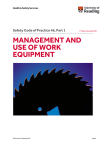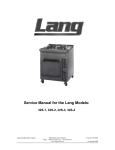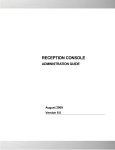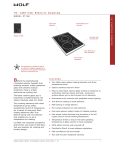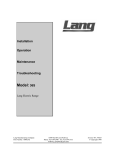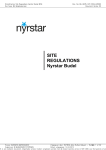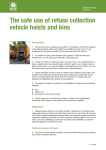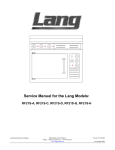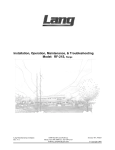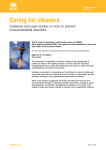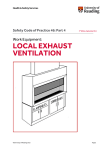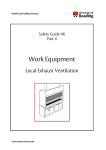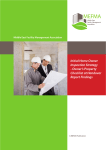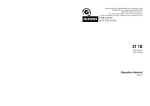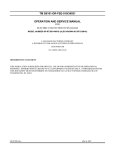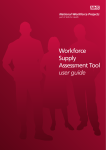Download The University of Reading Safety Guide 5
Transcript
Health and Safety Services Safety Guide 46 Part 1 Management and use of work equipment Governance Directorate Safety Guide 46 Part 1 Management and use of work equipment Safe use of work equipment Contents Summary .............................................................................................................................................................................................iii 1. Introduction ............................................................................................................................................................................. 5 2. Scope .......................................................................................................................................................................................... 5 3. Responsibilities ....................................................................................................................................................................... 6 3.1. Duties of managers ......................................................................................................................................6 3.2. Duties of staff and students ......................................................................................................................6 3.3. Duties of tenants ..........................................................................................................................................7 4. General requirements........................................................................................................................................................... 7 4.1. Health and safety information required prior to purchase/hire .....................................................7 4.1.1. Checking that equipment is safe 7 4.2. Competence and training ..........................................................................................................................8 4.2.1. Restricted use equipment 8 4.2.2. Legal requirements for specialist equipment 8 4.3. Markings .........................................................................................................................................................9 4.4. Guarding .........................................................................................................................................................9 4.5. Controls ..........................................................................................................................................................9 4.6. Specialist and mobile equipment ......................................................................................................... 10 4.6.1. Non-mobile equipment 10 4.6.2. Mobile work equipment 10 4.6.3. Other requirements for mobile equipment 10 4.6.4. Motor vehicles – cars and goods vehicles 10 5. Maintenance, Pre-use checks, Inspections, and Thorough Examinations ......................................................... 11 5.1. Maintenance ............................................................................................................................................... 11 5.2. Pre-use checks ............................................................................................................................................ 11 5.3. Inspection .................................................................................................................................................... 11 5.4. Thorough examination............................................................................................................................ 12 5.5. Equipment that does not need a formal inspection ....................................................................... 12 6. Scientific and laboratory equipment ............................................................................................................................. 12 6.1. Designed in-house ..................................................................................................................................... 13 6.1.1. Exemptions 13 6.2. Inspection and examination of laboratory equipment .................................................................. 13 7. References .............................................................................................................................................................................. 14 Health and Safety Services Governance Directorate Tel 0118 378 8888 Edition 01 November 2009 Health and Safety Services ii November 2009 Safety Guide 46 Part 1 Management and use of work equipment Summary This Safety Guide (Part 1) summarises the key requirements of the Provision and Use of Work Equipment Regulations (1998) (PUWER). It outlines the management systems required within the University for purchasing, using and maintaining work equipment. Parts 2 to 6 of the Guide (separate documents) contain detailed information on specific types of hazardous or safety-critical equipment, namely: Part 2 Pressure Systems Part 3 Gas systems Part 4 Local Exhaust Ventilation (LEV) Part 5 Cryogenic liquids and gases Part 6 Woodworking and engineering workshop machinery PUWER, and hence this Guide, apply to all equipment used in the workplace. The general requirements are that work equipment is: Suitable for the tasks for which it is used. Safe for use. Maintained in a safe condition. Where required, inspected to ensure that it remains in a safe condition and is fit for use. Used only by people who have received adequate information, instruction and training. Where intrinsically hazardous or safety critical equipment/systems are in use, users are assessed as competent before being authorised to use such equipment unsupervised. Accompanied by suitable safety measures such as protective devices, markings and warnings. Equipment will perform better, be safer for use and maintain its value if its scheduled maintenance is carried out. It is implicit in the University’s insurance policy that equipment and facilities will be maintained so as to protect our staff and assets. This Guide also includes information to enable Schools/Directorates/Units to comply with the inspection and examination requirements of the Pressure Systems Safety Regulations 2000; sections of the Control of Substances Hazardous to Health Regulations (COSHH); and the safety requirements of the Supply of Machinery (Safety) Regulations 1992, as amended. NOTE: Other Safety Guides not referenced in this document have sections that are also relevant to work equipment, such as working at height and lifting equipment. A complete listing is available on Health & Safety Services website. Health and Safety Services iii November 2009 Safety Guide 46 Part 1 Management and use of work equipment Figure 1 Procedural summary for management of work equipment Identify work equipment and competent person(s) responsible for it Undertake risk assessment, covering conditions of use; users, normal, abnormal and emergency operating conditions; maintenance requirements Identify requirements for user pre-use checks; formal inspections, including maintenance; thorough examination. Does equipment need formal inspections/tests/thorough examination in accordance with specific legislation ? NO Confirm: • Pre-use and user checks • Maintenance requirements in accordance with manufacturer's instructions and your risk assessment Applies to e.g.: • Woodworking and engineering machinery • Vehicles • Laboratory equipment • All other work equipment where safety depends on regular checks, inspections and maintenance Lifting equipment – requires: • Thorough examination and test in accordance with LOLER, or • Thorough examination and test in accordance with a written scheme of examination • Periodic inspections where deterioration may occur See SG41 Undertake maintenance, inspection and test as required Health and Safety Services YES Pressure systems – require: • Written scheme of examination • System records, including schematic drawing, operating limits, operating instructions • Inspections, tests & maintenance in accordance with written scheme See SG 46 Part 2 Gas systems – require: • Compliance with relevant trade association codes of practice e.g. industrial gases, gas regulators • Written scheme of examination etc (as for pressure systems, above) • Annual safety checks for appliances in tenanted residential accommodation See SG46 Part 3 Local Exhaust Ventilation (LEV) – requires: • ‘Annual’ thorough examination and test • User manual and instructions for use • System logbook (or equivalent records) • Test labels on equipment See SG46 Part 4 Train users iv Keep records of inspections, examinations, tests and user training November 2009 Safety Guide 46 Part 1 Management and use of work equipment 1. Introduction This Safety Guide sets out what managers, staff, students and tenants have to do to ensure that risks are minimised when using any equipment at work. It provides general guidance on the purchase, use, inspection and maintenance of equipment. Detailed guidance on intrinsically hazardous and safety critical work equipment relevant to the University is given in separate Parts to this Guide: Part 2 Pressure Systems Part 3 Gas systems Part 4 Local Exhaust Ventilation (LEV) Part 5 Cryogenic liquids and gases Part 6 Woodworking and engineering workshop machinery The key management requirements of the Provision and Use of Work Equipment Regulations (1998) (PUWER) are summarised. Also included are requirements from other legislation such as the Pressure System Safety Regulations 2000, the Control of Substances Hazardous to Health Regulations (COSHH), the safety requirements of the Supply of Machinery (Safety) Regulations 1992, as amended, and the Employer’s Liability (Defective Equipment) Act 1969. 2. Scope The scope of work equipment is extremely wide. It covers almost any equipment used at work, including: 'Tool box tools' such as hammers, knives, handsaws, meat cleavers etc. Single machines such as drilling machines, circular saws, photocopiers, combine harvesters etc. Scientific equipment and apparatus such as glassware, analysers, balances, microscopes, autoclaves, electric mantles etc. Lifting equipment such as hoists, lift trucks, elevating work platforms, lifting slings etc. Mobile work equipment such as cherry pickers, electric vehicles, all-terrain vehicles etc. Other equipment such as ladders, pressure water cleaners, office equipment etc. An installation such as a series of machines connected together, for example experimental rigs, scaffold towers, or other access equipment. The following are not classified as work equipment for the purpose of this guide: Livestock. Substances (for example, acids, alkalis, slurry, cement, cleaning products - these come under the COSHH regulations). Structural items (for example, walls, stairs, roofs - these are covered by building regulations and the Workplace (Health, Safety and Welfare) Regulations. Private cars are not covered by PUWER but any vehicle purchased by the University is. However, the University has a general duty as an employer to seek confirmation that private cars used for work purposes are safe and legal. The definition of ‘use’ is wide and includes all activities involving work equipment such as stopping or starting the equipment, repair, modification, cleaning, transporting, maintenance and servicing. In many cases there is specific legislation related to other types of work equipment. More detailed information is given in other University Safety Guides e.g. SG11 Electrical Equipment; SG14 Part 6 Microbiological Safety Cabinets; SG20 Safe Use of X-ray Equipment; SG21 Lasers; SG40 Lifting Operations and Equipment; SG45 Working at Height; etc. and accompanying Safety Notes for the use Health and Safety Services 5 November 2009 Safety Guide 46 Part 1 Management and use of work equipment of equipment such as centrifuges and ladders. Please check the Health & Safety Services website for details: http://www.reading.ac.uk/internal/health-and-safety/resources/hs-resources-guidance.aspx. 3. Responsibilities Most of the fixed systems forming the infrastructure within University buildings (such as lifts, boilers, steam mains, heating and ventilation systems, air conditioning, local exhaust ventilation (LEV) and compressed gas supplies) are the responsibility of the Maintenance Services Department (MSD) of Facilities Management Directorate (FMD). Equipment owned and/or operated by Schools is the responsibility of the School. This includes e.g. ‘mobile’ LEV systems such as some microbiological safety cabinets, pressure systems such as autoclaves, and cryogenic and specialist gas systems. Where there is any doubt about ‘ownership’, the user and FMD must reach an agreed solution so that equipment is not neglected. 3.1. Duties of managers Heads of Schools/Directorates/Halls and other unit managers must ensure that: The use of work equipment is risk assessed and where there are significant risks, a safe system of work is in place. Equipment is suitable for the task (e.g. a circular saw is not suitable for cutting a rebate, nor to use knives where scissors would be more appropriate). Equipment is suitable for the location (e.g. not to use 240v electrical equipment in wet environments). Equipment is maintained in efficient working order and good repair (efficient refers to operating safely rather than productively) Maintenance is only carried out by competent persons. Equipment is checked frequently (for safety features, this is normally referred to as ‘operators daily checks’) to ensure that safety related features are functioning correctly. Lighting levels are adequate to use the work equipment safely. Work equipment is designed and installed in such a way that maintenance operations can be carried out safely. Staff and students receive training, where appropriate, in the use of work equipment. Users of intrinsically hazardous equipment or equipment/systems that are safety critical (referred to as ‘restricted use’ equipment) are assessed as competent and authorised to use the equipment before being allowed to work unsupervised (see section 4.2). Where required by risk assessment or specific legislation, equipment is subject to formal inspections and thorough examinations by a competent person (see section 4.5). They are aware that the above responsibilities apply if employees or students use their own equipment for work purposes. 3.2. Duties of staff and students All staff and students must ensure that: They use equipment suitable for the task, and in a suitable location. They only operate work equipment which they have been trained and authorised to use. Those under the age of 18 do not operate work equipment without adequate supervision. All work equipment is subject to a pre-use visual check for major defects. Any defects in work equipment are reported immediately to the supervisor. Work equipment that is clearly defective or is marked ‘Do Not Use’ or ‘Failed’ is not used. Health and Safety Services 6 November 2009 Safety Guide 46 Part 1 Management and use of work equipment 3.3. Duties of tenants All tenants must ensure that: Any defects in work equipment where the University is responsible for maintenance (e.g. passenger or goods lifts in shared buildings) are reported immediately to the FMD Helpdesk (0118 378 7000). The University is informed of any work equipment that they plan to introduce into a University building, that may have a ‘Danger Zone’ (e.g. x-ray generating machines). Appropriate health and safety information is given to MSD or other persons appointed by the University (e.g. maintenance contractors) when maintenance is to be carried out (e.g. COSHH substances used in a fume cupboard when work on the extract system is required). 4. General requirements Whilst the range of work equipment used within the University varies substantially, the following is a list of general requirements that are applicable in most cases, or refers to specific requirements in PUWER. 4.1. Health and safety information required prior to purchase/hire Before acquiring new equipment, Schools/Directorates should check that it will be safe and fit for purpose. This may mean obtaining information from suppliers, and where it is custom-built equipment, explaining your requirements so that causes of injury and ill health are designed out. 4.1.1. Checking that equipment is safe When buying or hiring new equipment, Schools/Departments will need to ask the supplier for information, such as: Is the equipment suitable for the task and fit for purpose? What health and safety risks might there be when using the machine? Are there any dangerous parts and what guards will be provided? Will it need emergency stop controls and how will it be isolated? How do the controls and control systems work? Will dust or fumes, etc. be produced by the machine? If these are likely to be in significant quantities, can an existing extraction system be adapted to cope with the new machine or will you have to buy a new system? Has the machinery been designed to minimise the noise and vibration levels produced? Are there any extremely hot or very cold parts of the machine, and can they be insulated or protected? Are there any lasers or thickness gauges, and can any exposure to radiation be eliminated? If not, what precautions are there to stop any exposure to radiation? What has been done to eliminate the risk of electric shock, particularly during maintenance work, when covers or control panel doors may be open? Are there possible risks from other sources of energy such as hydraulic or pneumatic? Is there clear information about installation, maintenance and breakdown procedures? Will the supplier inform the University if problems arise with similar machines bought by other users? Health and safety information and instructions on the safe use of the work equipment must be made available to: Those responsible for the equipment (technicians, supervisors and managers). People using the equipment, including staff and students. People maintaining the equipment. Health and Safety Services 7 November 2009 Safety Guide 46 Part 1 Management and use of work equipment 4.2. Competence and training The competence of any individual to operate, supervise or manage the use of the equipment should be evaluated, with subsequent training of the employee to make up the shortfall between their current level of competence and that required to carry out the work safely. Assessments for young persons (those under the age of 18) should be more stringent to take account of their inexperience. Training should be provided for those who occasionally deputise for others, including frequent refresher training. All training should be recorded (including a summary of the content of such training where there are significant risks in using the equipment). 4.2.1. Restricted use equipment Supervisors/managers must identify equipment for restricted use and only authorise, in writing, competent persons to use such equipment. Examples of equipment for restricted use include: Intrinsically hazardous equipment such as lathes, milling machines, woodworking machinery. Cryogenic liquid dewars and decanting systems. Depending on circumstances of use, safety critical equipment/systems and engineering controls such as fume hoods, safety cabinets, interlock systems associated with high magnetic fields, lasers etc. Specialist vehicles, such as electric carts, all terrain vehicles and fork lift trucks. Guidance: Equipment such as fume hoods and safety cabinets are standard equipment in many University laboratories and would not normally be regarded as ‘restricted’ use equipment. However users still need to be receive basic training in good laboratory practice and correct operating procedures. There may be circumstances such as in Category 3 laboratories where access and usage has to be restricted to named people who have been formally assessed as competent. A list of designated, named users should be displayed beside restricted use equipment. No person under the age of 18 is allowed to operate restricted use equipment. Written Standard Operating Procedures (SOPs) or Local Rules must be drawn up for restricted use equipment. These must include: Information about the health and safety aspects arising from use of the equipment. Any limitations on use. Any foreseeable difficulties that could arise. The methods to deal with them, including emergency procedures. SOPs/Local Rules must be clear and easy to understand, in particular for any user whose first language may not be English. Any such rules must be readily available for reference at any time (e.g. not on a computer system that is not readily accessible) and must be up to date. 4.2.2. Legal requirements for specialist equipment There are some categories of equipment where there are legal requirements for the user to have a certificate of competence or specialist training. This includes: Chainsaw operations - All chainsaw operators must have a nationally-recognised certificate of competence appropriate to the work being undertaken. See HSE leaflet AFAG805, Training and Certification, published 04/03, for details of current training and certification and training requirements. Fork lift trucks – all drivers must have training and certification in accordance with HSE’s Approved Code of Practice and Guidance Rider-Operated lift trucks: Operator training, L117. This includes basic and specific training off the job, on the job familiarisation training, and refresher training. Abrasive wheels. Health and Safety Services 8 November 2009 Safety Guide 46 Part 1 Management and use of work equipment Any vehicle with a cargo capacity of over 3.5 tonnes. Any earth moving or construction plant. All watercraft used in a business capacity. Any member of the University who uses such equipment must comply with these requirements. Guidance: Further information on working safely with fork lift trucks is given in ‘Safety in working with lift trucks’, HSG 6, rd 3 edition, 2000, HSE. This includes age limits and fitness requirements. Contact H&SS for more information. 4.3. Markings Any new equipment brought into the workplace must bear a CE Marking or be accompanied by a certificate or declaration of conformity as required by EC product Directives. However a CE mark is only a claim by the manufacturer that the machinery is safe and they have met the relevant supply law - the owning Department still has to assess the equipment to make sure that it is safe. See also section 5.1. Work equipment must be clearly marked with the identification of controls, safe working loads and warnings and warning devices appropriate for health & safety. 4.4. Guarding Access to dangerous parts of equipment must be prevented by physical guarding and safe systems of work. Such systems should operate to prevent: Articles falling or being ejected from work equipment. Work equipment catching fire. Unintended or premature explosion of the stock materials or work equipment. 4.5. Controls Injury from work equipment as a result of very high or low temperature (such as furnaces or liquid nitrogen dewars) must be prevented by engineering controls, and where this is not practicable, by the use of personal protective equipment. Justification for reliance on personal protective equipment cannot be on grounds of cost or convenience. Work equipment must have adequate, readily accessible, visible and identifiable controls to start and stop the equipment, including an emergency stop where required by the nature of the hazard. All workshop fixed machinery, pressure and vacuum systems must have a single action stop switch that is: Readily accessible by the user. Accessible without moving into a hazard area. Clearly marked as the stop system for that machine. All stop devices must bring the machine to a safe stop in a reasonable time (some machines have recommended stop times in the HSE guidance documents). All stop devices must place the machine in a safe condition i.e. the resumption of power should not in itself create a hazard. Any fault in the control system of work equipment must fail safe so that it is always possible to recover to a safe condition. Any emergency stop or identified maintenance isolation switches must isolate the entire machine, including: Any spot or task lighting. All controls. Health and Safety Services 9 November 2009 Safety Guide 46 Part 1 Management and use of work equipment Any measurement or monitoring systems connected to the machine (this is a frequent failing in research equipments with a number of serious incidents and fatalities). Work equipment must be provided with suitable means to isolate it from all sources of energy, so that inadvertent reconnection is not possible e.g. during maintenance. This could be as simple removing the plug from the electrical supply socket, or it may require a more sophisticated isolation switch or valve. Where stopping the equipment or the power supply would result in danger e.g. loss of cooling, or stored energy such as capacitors, pressure or heat, there must be a means of protecting workers. 4.6. Specialist and mobile equipment Certain types of equipment require means of preventing it overturning and causing injury to operators. 4.6.1. Non-mobile equipment Work equipment which might fall over, collapse, or overturn, such as scaffolding, temporary work platforms or some woodworking and metal working machinery must be stabilised e.g. by clamping, bolting or other means of tying or fastening down. 4.6.2. Mobile work equipment Where mobile work equipment could roll over, protection for the occupant(s) must be provided to prevent them being crushed. Protection may be a frame or cab capable of withstanding the forces that would be sustained if the vehicle were to roll through 180 degrees or more. Restraining systems such as seat belts must also be fitted. If older equipment (i.e. was in use before 5 December 1998) is at risk of overturning, and it is not reasonably practicable to fit rollover protection and a restraining system, the equipment must not be used. 4.6.3. Other requirements for mobile equipment Mobile work equipment such as fork lift trucks and electric carts must have facilities to prevent the vehicle being started by unauthorised persons, such as controlled access to starter keys. Equipment not specifically designed for carrying people must not be used for that purpose, except in exceptional circumstances. Where such equipment is used to carry people, e.g. trailers used to carry farm workers at harvest time, there must be features to prevent people falling, and to enable them to stabilise themselves when travelling e.g. handholds. Where mobile equipment is intended to carry people, it must have suitable side, front and rear barriers or guard rails to prevent people from falling when it is travelling. 4.6.4. Motor vehicles – cars and goods vehicles Cars and other motor vehicles are covered by the Road Traffic Act for standards of road worthiness. However, there are many factors over and above roadworthiness that can contribute to safe use of a vehicle, such as experience, weather, load, distance and time. In addition, the driver is often away from observation or direct supervision; and the effects of other road/vehicle users’ competence and actions can have an adverse effect on the safety of University staff. Therefore, particular attention must be given to: Vehicle condition, suitability for the task, and legal aspects such as adequate insurance, MOT etc. The competence and fitness of the driver, including licence, qualifications and insurance for the class of vehicle. The journey. Guidance: H&SS are developing a new policy on Road Risk and Driving at Work. This will expand on the brief summary above. Health and Safety Services 10 November 2009 Safety Guide 46 Part 1 Management and use of work equipment 5. Maintenance, Pre-use checks, Inspections, and Thorough Examinations All equipment must be maintained in a safe condition and be fit for use. Most equipment should be subject to pre-use checks by the user, some will additionally require formal inspections and/or thorough examinations by a competent person. Most will require some form of maintenance. 5.1. Maintenance Maintenance means the carrying out routine and special maintenance procedures at intervals accordance with the manufacturer’s maintenance manual e.g. checking safety critical systems, adjusting parts, lubricating bearings, replacing clogged filters etc. Some of the procedures will be necessary to keep the equipment in working order, others will be required for safety reasons. There is no legal requirement to keep a log of maintenance activities, but it could prove useful for future maintenance activities. If a log is kept there is a legal requirement to keep it up to date. 5.2. Pre-use checks These are generally visual checks that an operator may make before using the work equipment, such as checking for scorch marks on the plug of portable electrical equipment, checking the rungs of a ladder for damage, checking handles of saucepans/stockpots are secure and inspection of laboratory glassware for chips and cracks. These checks do not need to be recorded. Safe systems of work should identify the need for such checks. 5.3. Inspection The purpose of an inspection is to identify whether the equipment can be operated, adjusted and maintained safely and that any deterioration (for example defect, damage, wear) can be detected and remedied before it results in unacceptable risks. Inspection is essential where failure of the equipment could foreseeably result in a major injury or worse. Inspections must be carried out in accordance with a competent person’s assessment (e.g. of need, frequency, type of inspection). The manufacturer’s maintenance manual which will specify routine and specific maintenance requirements at predetermined intervals, which may include inspections. Inspection frequencies will depend on: The intensity of use. The operating environment. The risk to health and safety from malfunction or failure. Records of inspection must be kept by the owning department until at least the date of the next inspection. Inspections should include, where appropriate, visual checks (external and internal), functional checks and testing/dismantling. An inspection should always include those safety-related parts which are necessary for safe operation of equipment, for example overload warning devices and limit switches. As part of an inspection, a functional or other test may be necessary to check that the safetyrelated parts are working as they should be and that the work equipment is structurally sound e.g. non-destructive testing of safety-critical parts. Guidance: Competent persons for inspections A competent person to define inspection requirements may be a department manager, supervisor or senior technician who is experienced with the equipment and knows what should be inspected to detect faults or damage arising from deterioration. The actual inspection may be carried out by a member of staff who knows what to look at, what to look for (fault finding) and what to do to report a fault or keep records. For more complex equipment, it may be necessary to bring in expertise, for example the manufacturer or supplier, or an engineering inspector. Health and Safety Services 11 November 2009 Safety Guide 46 Part 1 Management and use of work equipment NB The inspection requirements for ladders, tower scaffolds and scaffolding are set out in Safety Guide 35 Work at Height. 5.4. Thorough examination Some work equipment is required to have a thorough examination under other legislation e.g. the Pressure Systems Safety Regulations (see Safety Guide 46 Part 2); Gas Safety (Installation and Use) Regulations (see Safety Guide 43); Lifting Operations and Lifting Equipment Regulations (see Safety Guide 41); and the Control of Substances Hazardous to Health Regulations (see Safety Guide 28). Examples are goods and passenger lifts, boiler plant, steam heating systems, and LEV systems in laboratories and workshops. For these types of fixed installations, MSD are responsible for ensuring that the thorough examinations are drawn up and carried out, usually by external competent persons (the University’s engineering inspector). NB Further details of requirements for lifting equipment and gas systems are given in Safety Guides 41 and 46 Part 3 respectively. If a School/Department acquires any equipment that requires a thorough examination the responsibility for arranging the thorough examination rests with them. They should contact the University’s engineering inspector to make arrangements (contact details available via the Insurance Office). The School/Department is responsible for any costs arising. Guidance on delivery of reports of thorough examinations RSA currently undertake most statutory inspections and examinations of University equipment. The RSA engineering inspector’s report will normally be sent electronically to MSD, who will forward it on to the owning School/Department. Guidance on thorough examinations and insurance inspections: Inspections under section 5.3 above will only be needed for such work equipment if the thorough examination does not fully cover all the significant health and safety risks which are likely to arise from the use of the equipment. Thorough examination is often (wrongly) referred to as an insurance inspection. Thorough examinations do not have to be carried out by an insurance company, just by a competent person. In practice the thorough examinations are often carried out by an insurance company simply because the insurers have developed this commercial market. 5.5. Equipment that does not need a formal inspection Where the failure of work equipment will not normally result in a major injury, a formal inspection is not normally required. Examples include: Office furniture. Hand tools. Non-powered machinery. Some powered machinery such as a reciprocating fixed-blade metal cutting saw. The rule of thumb is to consider if the failure of work equipment would result in a major injury in normal use. Adequate training in the use of this type of equipment and appropriate instruction and supervision will mitigate the risk of injury. Wherever practicable, pre-use checks should always be carried out. 6. Scientific and laboratory equipment The type of work equipment used in scientific departments is extremely diverse. It can range from simple glassware to in-house designed experimental rigs and multi-million pound microscopes and Health and Safety Services 12 November 2009 Safety Guide 46 Part 1 Management and use of work equipment scanners. In all cases the manufacturer’s maintenance schedule within the user manual should be adhered to. 6.1. Designed in-house If a user manual is not available, because the equipment has been designed and built in-house, one should be written and the principles of the Supply of Machinery (Safety) Regulations 1992 applied. These regulations place duties upon those who supply certain machinery and safety components, including manufacturers, importers and others in the supply chain. They set out the essential requirements which must be met before certain machinery or safety components may be supplied in the UK. In general this is covered by the requirement for equipment to have a CE marking – see section 4.3. If you are importing or constructing the machine yourself, for use within the University, you may take on the responsibilities of the supplier/manufacturer, depending on the type of equipment. Within the University the types of products likely to be within the scope of these regulations include, but are not limited to: Electrical equipment, excluding low voltage switchgear and control gear and electric motors Gas appliances Machines that present a safety risk from moving parts/mechanical operation Safety components Lifting accessories Drive systems There are basically three steps to meeting the requirements of the Machinery Safety Regulations: 1. The responsible person should ensure that machinery and safety components satisfy the relevant essential health and safety requirements of the Supply of Machinery (Safety) Regulations and that, where appropriate, relevant conformity assessment procedures have been carried out. 2. The responsible person must issue a declaration of conformity (or a declaration of incorporation) which is issued with the finished product to be available to the user. This will contain details such as the manufacturer's address, the machinery type and serial number, and the harmonised European, or other standards, used in design. 3. 6.1.1. When the first two steps have been satisfactorily completed, the responsible person or person supplying or assembling the final product should affix the CE marking if they are satisfied it is safe. Exemptions You should check whether or not the type of equipment that you import directly, or design and construct in-house, is covered by the Machinery Safety Regulations. If it is, then the only exemption from the conformity assessment procedures that may apply is for machinery specially designed and constructed for research purposes for temporary use in laboratories. Once in regular use, even for the purpose of research, the conformity procedures will apply. If exempt, there is still a duty to ensure safety, and if necessary to demonstrate it by risk assessment, technical documentation etc. 6.2. Inspection and examination of laboratory equipment Some scientific equipment will require inspection and/or thorough examination under specific legislation. The manufacturer’s manual will normally set out the legal requirements, however some examples are given below: Pressure systems - the Pressure Systems Safety Regulations (PSSR) apply, see section 5.3 below and Safety Guide 46 Part 2. Gas fired equipment such as ovens and furnaces – the Gas Safety (Installation and Use) Regulations apply – see Safety Guide 46 Part 3. Health and Safety Services 13 November 2009 Safety Guide 46 Part 1 Management and use of work equipment Local Exhaust Ventilation – COSHH applies, see Safety Guide 46 Part 4. 7. References Accreditation for the inspection of local exhaust ventilation (LEV) plant RG04 United Kingdom Accreditation Service 2000 (available at: www.ukas.com). An introduction to local exhaust ventilation. HSG37 Second edition HSE Books 1993 ISBN 0 7176 1001 2. Clearing the air: A simple guide to buying and using local exhaust ventilation (LEV). INDG 408 HSE Books 2008 ISBN 978 0 7176 6301 9. EH40/2005 Workplace exposure limits Table 1: List of approved workplace exposure limits (as consolidated with amendments October 2007). http://www.hse.gov.uk/coshh/table1.pdf. Maintenance, examination and testing of local exhaust ventilation. HSG54 Second edition HSE Books 1998 ISBN 0 7176 1485 9. Safe use of woodworking machinery – Provision and Use of Work Equipment Regulations 1998 as applied to woodworking. Approved Code of Practice and Guidance L114. 1998. ISBN 0 7176 1630 4. Safe use of work equipment – Provision and Use of Work Equipment Regulations 1998. Approved Code of Practice and Guidance L22. Third edition 2008. ISBN 978 0 7176 6295 1. Safe use of ladders and stepladders: An employers’ guide. INDG 402. HSE Books. First published 10/05 ISBN 978 0 7176 6105 3. Safety at autoclaves, PM73. HSE 1998, ISBN 0 7176 1534 0 Supply of Machinery (Safety) Regulations 1992 (as amended). Rider-Operated lift trucks: Operator training. HSE Approved Code of Practice and Guidance L117. 1999. ISBN 0-717-62455-2. Supplying new machinery, HSE INDG270. Machinery - Guidance notes on the UK Regulations. Sept 2009. Department for Business, Innovation and Skills. URN 09/P86. Health and Safety Services 14 November 2009














